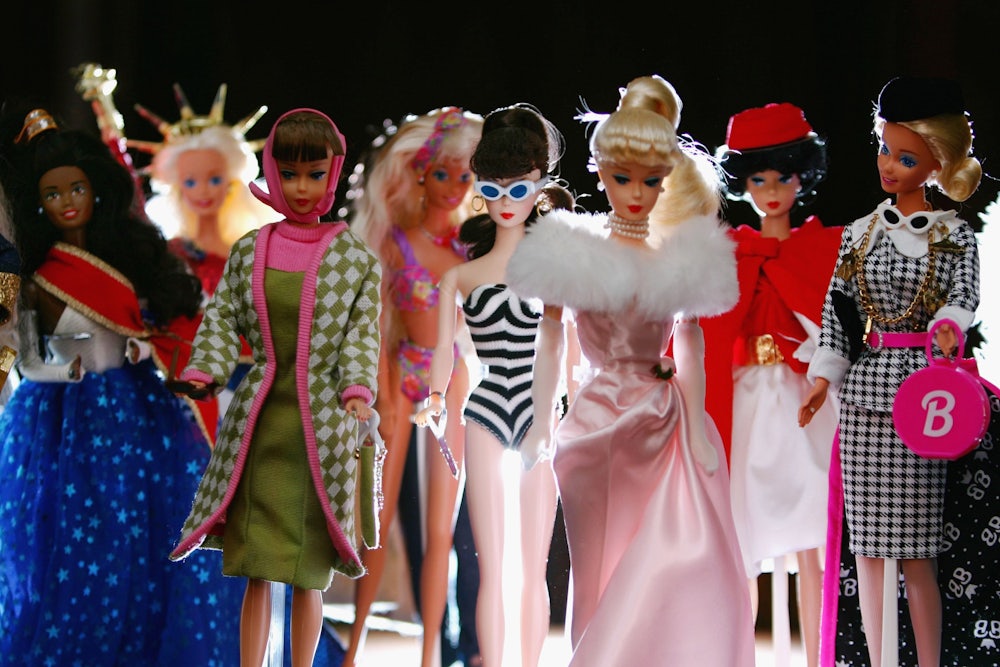Barbie is 35 this year and along with a special-edition vinyl reproduction of the original 1959 model, Mattel has launched a new Bedtime Barbie. Not a Barbie fan, I immediately imagined the worst (fuschia teddy…) and couldn’t resist a classic parental shudder. Could there be a better symbolic indictment of juvenile consumer culture? Casting three decades of coyness aside, the fashion doll had, to judge by her name, finally exposed her disreputable origins. (Barbie was inspired by salacious Lilli, a German gag item for men.) The fact that “Bedtime Barbie” shared Christmas season pre-eminence with Mighty Morphin Power Rangers clinched the diagnosis of advanced decadence in the playroom.
But Bedtime Barbie, I discovered on holiday shopping expedition to Toys “R” Us, is actually dressed like every little girl’s grandmother. She wears a long fuzzy pink nightgown, with demure white lace at the throat and cuffs. The bigger surprise is the look of “the first soft body Barbie doll you can sleep with” underneath her nightwear. I peeked, eager to see (and feel) a cushiony version of the mighty bust. Bedtime Barbie turns out to be barely distinguishable from the refined-looking rag dolls every little girl’s great-grandmother stitched delicate clothes for, except she has just a little extra stuffing above the waist.
The cuddly Barbie was a calming influence on me: suddenly the mid-’90s panic about dangerously mindless kid merchandise seemed like, well, panic. Even a couple of hours in a mass-market madhouse like Toys “R” Us didn’t revive alarmism. Sure, there’s too much of everything (15,000-20,000 kinds of toys on the shelves, out of a total market of 120,000). But just look at all the floor space devoted to wholesome sports equipment. Construction toys clutter the shelves. Kitchen play paraphernalia is made of the sturdiest plastic—not all of it pink. And the prices, as Toys “R” Us guarantees, can’t be beat. As for the junk, I asked for Jibba Jabber, the most ludicrous sounding toy on the list of “hot” Christmas items from Toy Manufacturers of America Inc., the industry trade association. No salesperson had a clue of what I was talking about.
Above all, a cruise down the aisles undermined my support for the favorite reform currently urged on American toy manufacturers: liberate girls from their doll ghetto and give them the kind of dynamic toy opportunities boys enjoy. A disproportionate share of the 5,000-6,000 new playthings introduced into the toy market every year are aimed, unfairly it is claimed, at boys. It is unfair—for the boys. Roughly 80 percent of those novelties are flops, or quick fizzles, and a glance at the crummy combat- and sci-fi-oriented miscellany makes clear why. If diversifying for girls means forsaking loyalty to Barbie and sturdy Little Tyke kitchens in order to flirt with faddish T.V. tie-in action figures—or, say, Doctor Dreadful Food and Drink Labs (serving up Monster Warts and Putrid Potions)—that’s hardly progress.
On my way out, I finally found Jibba Jabber ($12.99). Following the instructions, I grabbed the creature’s long neck and shook it. Strangulated burbling ensued. The perfect release for a parent after a hard day in toyland, but happily I didn’t need it.
Not then. It was the trip to the opposite pole of kid consumer culture, Learningsmith, that was too much. All blond wood, warm lighting and soft carpets, the three-year-old educational toy store (now in twenty-five locations) has taken media-saturated recreation a step higher: here, the T.V. tie-ins have a college education. Learningsmith pays royalties to use PBS affiliate stations’ call letters, gets credited as a sponsor for a few shows, and features program-related products among its several thousand items.
“A General Store for the Curious Mind,” Learningsmith is a shrine to upscale pushiness. The products tout their high I.Q.s: “It’s O.K. To Be Smart!” “To Get a Smart Start,” “Creativity for Kids,” “Kindle Creativity.” Instead of aisles there are “discovery centers” with names like “Tower of Babel” (for flashcards, etc.) and “Socrates Sandbox” (for the preschool set). Computers are available, to make shopping an “interactive experience.”
In a place like this the curious mind quickly turns off. “The Backyard,” a CD-ROM computer game for ages 3-6 that is on Learningsmith’s shelf of recommended items, is promoted as “a fun place to explore nature, map reading and more.” Hey, why get dirty? For older children, Broderbund’s Aesop’s Fable, “Tortoise and the Hare,” gets the seal of approval. This “Living Book version includes dozens of hilarious new twists. Along the way, you’ll meet a score of delightfully animated characters—including Simon, the story-telling bird.” He’s purple, with red sneakers, and evidently loquacious. So much for aphoristic Aesop.
Creativity turns out to mean mostly creative packaging on the part of the manufacturer, designed to spare consumers any act of ingenuity or, for that matter, common sense. Why buy a $5 hunk of modeling clay and spread out an old newspaper when for $29 you can buy Claymation Clay Fun Pack? Inside the large, attractive box you’ll find a modest lump of clay, a smaller attractive box to keep it in, a plastic workmat and a modeling tool.
Leaving Learningsmith, I was accosted by a large inflatable toy called The Scream, for $27.95. Edvard Munch’s figure, blown up, is fifty inches tall. “It’s therapeutic,” the label promises: “The Scream will be the one who understands you when no one else does.” A swift punch didn’t bring half the pleasure of throttling Jibba Jabber.
